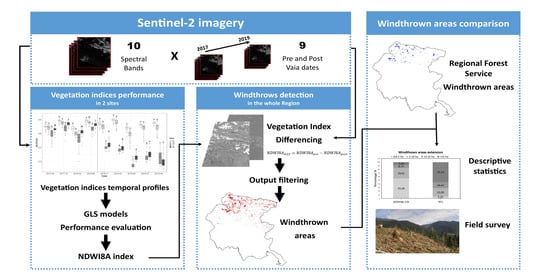Use of Sentinel-2 Satellite Data for Windthrows Monitoring and Delimiting: The Case of “Vaia” Storm in Friuli Venezia Giulia Region (North-Eastern Italy)
Abstract
:1. Introduction
- (1)
- determine the best band transformations (vegetation indices) to remotely separate damaged and un-damaged forest stands after a storm and to monitor the vegetation dynamics in the short period after the storm.
- (2)
- employing multispectral data in an image differencing change detection technique for windthrow detection in the whole Friuli Venezia Giulia Rregion.
2. Materials and Methods
2.1. Study Sites
2.2. Remote Sensing Data
- four bands at 10 m: B02, blue (490 nm); B03, green (560 nm); B04, red (665 nm) and B08, near-infrared (NIR) (842 nm).
- six bands at 20 m: B05–B07, three narrow bands in the vegetation red-edge (RE) spectral domain (705 nm, 740 nm, 783 nm); B8A, a narrow band in the near-infrared (NIR) (865 nm) and B11–B12, two large short-wave infrared (SWIR) bands (1610 nm and 2190 nm).
2.3. Statistical Analyses
2.4. Change Detection
2.5. Descriptive Statistics on Regional Windthrows
2.6. Map Validation
3. Results
3.1. Temporal Profiles of Vegetation Indices
3.2. Vegetation Indices Performance
3.3. Spectral Signatures
3.4. NDWI8A VID Windthrow Map
3.5. Map Validation
4. Discussion
4.1. Vegetation Indices Temporal Profiles
4.2. Spectral Reflectance of Vegetation after Windthrow
4.3. NDWI8A VID Windthrow Maps
4.4. Study Limitations
5. Conclusions
Supplementary Materials
Author Contributions
Funding
Institutional Review Board Statement
Informed Consent Statement
Data Availability Statement
Acknowledgments
Conflicts of Interest
References
- Dash, J.P.; Watt, M.S.; Bhandari, S.; Watt, P. Characterising Forest Structure Using Combinations of Airborne Laser Scanning Data, RapidEye Satellite Imagery and Environmental Variables. Forestry 2016, 89, 159–169. [Google Scholar] [CrossRef] [Green Version]
- Van Westen, C.J. Remote Sensing and GIS for Natural Hazards Assessment and Disaster Risk Management. In Treatise on Geomorphology; Elsevier: New York, NY, USA, 2013; pp. 259–298. ISBN 978-0-08-088522-3. [Google Scholar]
- I.P.C.C. Summary for Policymakers. In Climate Change and Land: An IPCC Special Report on Climate Change, Desertification, Land Degradation, Sustainable Land Management, Food Security, and Greenhouse Gas Fluxes in Terrestrial Ecosystems; IPCC/IGES: Hayama, Japan, 2019. [Google Scholar]
- Gardiner, B.; Schuck, A.R.T.; Schelhaas, M.J.; Orazio, C.; Blennow, K.; Nicoll, B. Living with Storm Damage to Forests: What Science Can Tell Us; European Forest Institute: Joensuu, Finland, 2013; Volume 3, pp. 1–132. [Google Scholar]
- Schuck, A.; Schelhaas, M.J. Storm damage in Europe–An overview. In Living with Storm Damage to Forests: What Science Can Tell Us; Gardiner, B., Schuck, A.R.T., Schelhaas, M.J., Orazio, C., Blennow, K., Eds.; European Forest Institute: Joensuu, Finland, 2013; Volume 3, pp. 15–24. [Google Scholar]
- Anderegg, W.R.; Kane, J.M.; Anderegg, L.D. Consequences of Widespread Tree Mortality Triggered by Drought and Temperature Stress. Nat. Clim. Change 2013, 3, 30–36. [Google Scholar] [CrossRef]
- Nowacki, G.J. The Effects of Wind Disturbance on Temperate Rain Forest Structure and Dynamics of Southeast Alaska; US Department of Agriculture, Forest Service: Portland, OR, USA, 1998; Volume 421.
- Sinton, D.S.; Jones, J.A.; Ohmann, J.L.; Swanson, F.J. Windthrow Disturbance, Forest Composition, and Structure in the Bull Run Basin, Oregon. Ecology 2000, 81, 2539–2556. [Google Scholar] [CrossRef]
- Peltola, H.; Gardiner, B.; Nicoll, B. Mechanics of wind damage. In Living with Storm Damage to Forests: What Science Can Tell Us; Gardiner, B., Schuck, A.R.T., Schelhaas, M.J., Orazio, C., Blennow, K., Eds.; European Forest Institute: Joensuu, Finland, 2013; Volume 3, pp. 31–38. [Google Scholar]
- Mitchell, S.J.; Ruel, J.-C. Modeling Windthrow at Stand and Landscape Scales. In Simulation Modeling of Forest Landscape Disturbances; Perera, A.H., Sturtevant, B.R., Buse, L.J., Eds.; Springer International Publishing: Cham, Switzerland, 2015; pp. 17–43. ISBN 978-3-319-19808-8. [Google Scholar]
- Carraro, V. La Furia del Vento che ha Danneggiato le Foreste dell’arco Alpino; Centro Studi per L’ambiente Alpino L: Cadore, Italy, 2019. [Google Scholar]
- Chirici, G.; Giannetti, F.; Travaglini, D.; Nocentini, S.; Francini, S.; D’Amico, G.; Calvo, E.; Fasolini, D.; Broll, M.; Maistrelli, F.; et al. Forest damage inventory after the “Vaia” storm in Italy. Forest 2019, 16, 3–9. [Google Scholar] [CrossRef] [Green Version]
- Directorate Space, Security and Migration, European Commission Joint Research Centre (EC JRC). Copernicus Emergency Management Service. Available online: https://emergency.copernicus.eu/ (accessed on 17 October 2019).
- Chang, J.; Ciais, P.; Herrero, M.; Havlik, P.; Campioli, M. Combining Livestock Production Information in a Process-Based Vegetation Model to Reconstruct the History of Grassland Management. Biogeosci. Eur. Geosci. Union 2016, 3757, 3757–3776. [Google Scholar] [CrossRef] [Green Version]
- Xue, J.; Su, B. Significant Remote Sensing Vegetation Indices: A Review of Developments and Applications. J. Sens. 2017, 2017, 1–17. [Google Scholar] [CrossRef] [Green Version]
- Copernicus Emergency Management Service EMSR334: Wind Storm in North-East of Italy. Available online: https://emergency.copernicus.eu/mapping/list-of-components/EMSR334 (accessed on 11 November 2019).
- Osmer, O. Metereologico regionale del FVG. In Il Clima del Friuli-Venezia Giulia; ARPA FVG–OSMER: Udine, Italy, 2014. [Google Scholar]
- ARPAOSMER Climate Data. Available online: https://www.meteo.fvg.it/clima/clima_fvg (accessed on 11 August 2019).
- GRASS Development Team. Geographic Resources Analysis Support System (GRASS) Software; Open Source Geospatial Foundation. 2019. Available online: http://grass.osgeo.org (accessed on 1 November 2019).
- Giorgi, R.; Petrucco, R.; Oriolo, G.; Strazzaboschi, L.; Pingitore, G. La nuova Carta degli habitat del Friuli Venezia Giulia, base per la valutazione ecologica del territorio. Reticula 2017, 16, 48–56. [Google Scholar]
- Copernicus Open Access Hub. Sentinel-2 Data. Available online: https://scihub.copernicus.eu/ (accessed on 30 September 2019).
- Stych, P.; Lastovicka, J.; Hladky, R.; Paluba, D. Evaluation of the Influence of Disturbances on Forest Vegetation Using the Time Series of Landsat Data: A Comparison Study of the Low Tatras and Sumava National Parks. ISPRS Int. J. Geo Inf. 2019, 8, 71. [Google Scholar] [CrossRef] [Green Version]
- Gitelson, A.A.; Merzlyak, M.N.; Grits, Y. Novel Algorithms for Remote Sensing of Chlorophyll Content in Higher Plant Leaves. In Proceedings of the IGARSS ’96. 1996 International Geoscience and Remote Sensing Symposium, Lincoln, NE, USA, 27–31 May 1996; IEEE: Lincoln, NE, USA, 1996; Volume 4, pp. 2355–2357. [Google Scholar]
- Gu, Y.; Wylie, B.K.; Howard, D.M.; Phuyal, K.P.; Ji, L. NDVI Saturation Adjustment: A New Approach for Improving Cropland Performance Estimates in the Greater Platte River Basin, USA. Ecol. Indic. 2013, 30, 1–6. [Google Scholar] [CrossRef]
- Frampton, W.J.; Dash, J.; Watmough, G.; Milton, E.J. Evaluating the Capabilities of Sentinel-2 for Quantitative Estimation of Biophysical Variables in Vegetation. ISPRS J. Photogramm. Remote Sens. 2013, 82, 83–92. [Google Scholar] [CrossRef] [Green Version]
- Einzmann, K.; Immitzer, M.; Böck, S.; Bauer, O.; Schmitt, A.; Atzberger, C. Windthrow Detection in European Forests with Very High-Resolution Optical Data. Forests 2017, 8, 21. [Google Scholar] [CrossRef] [Green Version]
- Rouse, J.W.; Haas, R.H.; Schell, J.A.; Deering, D.W. Monitoring Vegetation Systems in the Great Plains with ERTS. NASA Spec. Publ. 1974, 351, 309. [Google Scholar]
- Yoon, S.C.; Thai, C.N. Stereo Spectral Imaging System for Plant Health Characterization. In Technological Developments in Networking, Education and Automation; Elleithy, K., Sobh, T., Iskander, M., Kapila, V., Karim, M.A., Mahmood, A., Eds.; Springer: Dordrecht, The Netherlands, 2010; pp. 181–186. ISBN 978-90-481-9150-5. [Google Scholar]
- Chen, D.; Huang, J.; Jackson, T.J. Vegetation Water Content Estimation for Corn and Soybeans Using Spectral Indices Derived from MODIS Near- and Short-Wave Infrared Bands. Remote Sens. Environ. 2005, 98, 225–236. [Google Scholar] [CrossRef]
- Schultz, M.; Clevers, J.G.P.W.; Carter, S.; Verbesselt, J.; Avitabile, V.; Quang, H.V.; Herold, M. Performance of Vegetation Indices from Landsat Time Series in Deforestation Monitoring. Int. J. Appl. Earth Observ. Geoinform. 2016, 52, 318–327. [Google Scholar] [CrossRef]
- Gao, B. NDWI—A Normalized Difference Water Index for Remote Sensing of Vegetation Liquid Water from Space. Remote Sens. Environ. 1996, 58, 257–266. [Google Scholar] [CrossRef]
- Ceccato, P.; Flasse, S.; Tarantola, S.; Jacquemoud, S.; Grégoire, J.-M. Detecting Vegetation Leaf Water Content Using Reflectance in the Optical Domain. Remote Sens. Environ. 2001, 77, 22–33. [Google Scholar] [CrossRef]
- Merzlyak, M.N.; Gitelson, A.A.; Chivkunova, O.B.; Rakitin, V.Y.U. Non-Destructive Optical Detection of Pigment Changes during Leaf Senescence and Fruit Ripening. Physiol. Plant. 1999, 106, 135–141. [Google Scholar] [CrossRef] [Green Version]
- Lymburner, L.; Beggs, P.J.; Jacobson, C.R. Estimation of Canopy-Average Surface-Specific Leaf Area Using Landsat TM Data. Photogram. Eng. Remote Sens. 2000, 66, 183–192. [Google Scholar]
- Broge, N.H.; Leblanc, E. Comparing Prediction Power and Stability of Broadband and Hyperspectral Vegetation Indices for Estimation of Green Leaf Area Index and Canopy Chlorophyll Density. Remote Sens. Environ. 2001, 76, 156–172. [Google Scholar] [CrossRef]
- Yu, Y.; Saatchi, S.; Heath, L.S.; LaPoint, E.; Myneni, R.; Knyazikhin, Y. Regional Distribution of Forest Height and Biomass from Multisensor Data Fusion. J. Geophys. Res. Biogeosci. 2010, 115. [Google Scholar] [CrossRef] [Green Version]
- Wickham, H. Ggplot2: Elegant Graphics for Data Analysis; Springer: New York, NY, USA, 2016. [Google Scholar]
- Pinheiro, J.; Bates, D.; DebRoy, S.; Sakar, D. nlme: Linear and Nonlinear Mixed Effects Models. R Package Version 3.1-152. 2021. Available online: https://CRAN.R-project.org/package=nlme (accessed on 15 February 2021).
- Nakagawa, S.; Schielzeth, H. A General and Simple Method for Obtaining R2 from Generalized Linear Mixed Effects Models. Methods Ecol. Evol. 2013, 4, 133–142. [Google Scholar] [CrossRef]
- Jaeger, B. r2glmm: Computes R Squared for Mixed (Multilevel) Models. R Package Version 0.1.2. 2017. Available online: https://CRAN.R-project.org/package=r2glmm (accessed on 15 February 2021).
- Lenth, R. emmeans: Estimated Marginal Means, Aka Least-Squares Means. R Package Version 1.5.4. 2021. Available online: https://CRAN.R-project.org/package=emmeans (accessed on 15 February 2021).
- Rcore Team R. A Language and Environment for Statistical Computing; R Foundation for Statistical Computing: Vienna, Austria, 2021; Available online: https://www.R-project.org/ (accessed on 15 February 2021).
- Lu, D.; Mausel, P.; Brondízio, E.; Moran, E. Change Detection Techniques. Int. J. Remote Sens. 2004, 25, 2365–2401. [Google Scholar] [CrossRef]
- Wang, W.; Qu, J.J.; Hao, X.; Liu, Y.; Stanturf, J.A. Post-Hurricane Forest Damage Assessment Using Satellite Remote Sensing. Agric. For. Meteorol. 2010, 150, 122–132. [Google Scholar] [CrossRef]
- Vorovencii, I. Detection of Environmental Changes Due to Windthrows Using Landsat 7 ETM+ Satellite Images. Environ. Eng. Manag. J. 2014, 13, 565–576. [Google Scholar] [CrossRef]
- Yektay, Z. Sentinel-2 Images for Detection of Wind Damage in Forestry. Master Thesis, Aalto University, Espoo, Finland, 2019. [Google Scholar]
- De Langre, E. Effects of Wind on Plants. Annu. Rev. Fluid Mech. 2008, 40, 141–168. [Google Scholar] [CrossRef] [Green Version]
- Maki, M.; Ishiahra, M.; Tamura, M. Estimation of Leaf Water Status to Monitor the Risk of Forest Fires by Using Remotely Sensed Data. Remote Sens. Environ. 2004, 90, 441–450. [Google Scholar] [CrossRef]
- Martinez-Vilalta, J.; Anderegg, W.R.L.; Sapes, G.; Sala, A. Greater Focus on Water Pools May Improve Our Ability to Understand and Anticipate Drought-induced Mortality in Plants. New Phytol. 2019, 223, 22–32. [Google Scholar] [CrossRef] [Green Version]
- Hunt, E.R., Jr.; Qu, J.J.; Hao, X.; Wang, L. Remote Sensing of Canopy Water Content: Scaling from Leaf Data to MODIS. In Remote Sensing and Modeling of Ecosystems for Sustainability VI, Proceeding of the SPIE Optical Engineering + Application, San Diego, CA, USA, 20 August 2009; Gao, W., Jackson, T.J., Eds.; SPIE: San Diego, CA, USA, 2009; Volume 7454, p. 745409. [Google Scholar]
- Yilmaz, M.T.; Hunt, E.R.; Jackson, T.J. Remote Sensing of Vegetation Water Content from Equivalent Water Thickness Using Satellite Imagery. Remote Sens. Environ. 2008, 112, 2514–2522. [Google Scholar] [CrossRef]
- Marusig, D.; Petruzzellis, F.; Tomasella, M.; Napolitano, R.; Altobelli, A.; Nardini, A. Correlation of Field-Measured and Remotely Sensed Plant Water Status as a Tool to Monitor the Risk of Drought-Induced Forest Decline. Forests 2020, 11, 77. [Google Scholar] [CrossRef] [Green Version]
- Grybas, H.; Congalton, R.G. Land Cover Change Image Analysis for Assateague Island National Seashore Following Hurricane Sandy. J. Imaging 2015, 1, 85–114. [Google Scholar] [CrossRef] [Green Version]
- Lambers, H.; Chapin, F.S.; Pons, T.L. Plant Physiological Ecology; Springer: New York, NY, USA, 2008; ISBN 978-0-387-78340-6. [Google Scholar]
- Anderegg, J.; Yu, K.; Aasen, H.; Walter, A.; Liebisch, F.; Hund, A. Spectral Vegetation Indices to Track Senescence Dynamics in Diverse Wheat Germplasm. Front. Plant Sci. 2020, 10, 1749. [Google Scholar] [CrossRef] [Green Version]
- Ren, S.; Chen, X.; An, S. Assessing Plant Senescence Reflectance Index-Retrieved Vegetation Phenology and Its Spatiotemporal Response to Climate Change in the Inner Mongolian Grassland. Int. J. Biometeorol. 2017, 61, 601–612. [Google Scholar] [CrossRef]
- Chalker-Scott, L. Environmental Significance of Anthocyanins in Plant Stress Responses. Photochem. Photobiol. 1999, 70, 1–9. [Google Scholar] [CrossRef]
- Wright, I.J.; Reich, P.B.; Westoby, M.; Ackerly, D.D.; Baruch, Z.; Bongers, F.; Cavender-Bares, J.; Chapin, T.; Cornelissen, J.H.C.; Diemer, M.; et al. The Worldwide Leaf Economics Spectrum. Nature 2004, 428, 821–827. [Google Scholar] [CrossRef] [PubMed]
- Wyka, T.P.; Oleksyn, J.; Żytkowiak, R.; Karolewski, P.; Jagodziński, A.M.; Reich, P.B. Responses of Leaf Structure and Photosynthetic Properties to Intra-Canopy Light Gradients: A Common Garden Test with Four Broadleaf Deciduous Angiosperm and Seven Evergreen Conifer Tree Species. Oecologia 2012, 170, 11–24. [Google Scholar] [CrossRef] [PubMed] [Green Version]
- Knipling, E.B. Physical and Physiological Basis for the Reflectance of Visible and Near-Infrared Radiation from Vegetation. Remote Sens. Environ. 1970, 1, 155–159. [Google Scholar] [CrossRef]
- Gausman, H.W. Leaf Reflectance of Near-Infrared. Photogram. Eng. 1974, 40, 183–191. [Google Scholar]
- Johnson, D.M.; Smith, W.K.; Vogelmann, T.C.; Brodersen, C.R. Leaf Architecture and Direction of Incident Light Influence Mesophyll Fluorescence Profiles. Am. J. Bot. 2005, 92, 1425–1431. [Google Scholar] [CrossRef] [Green Version]
- Ollinger, S.V. Sources of Variability in Canopy Reflectance and the Convergent Properties of Plants: Tansley Review. New Phytol. 2011, 189, 375–394. [Google Scholar] [CrossRef]
- Wermelinger, B. Ecology and Management of the Spruce Bark Beetle Ips Typographus—A Review of Recent Research. Forest Ecol. Manag. 2004, 202, 67–82. [Google Scholar] [CrossRef]
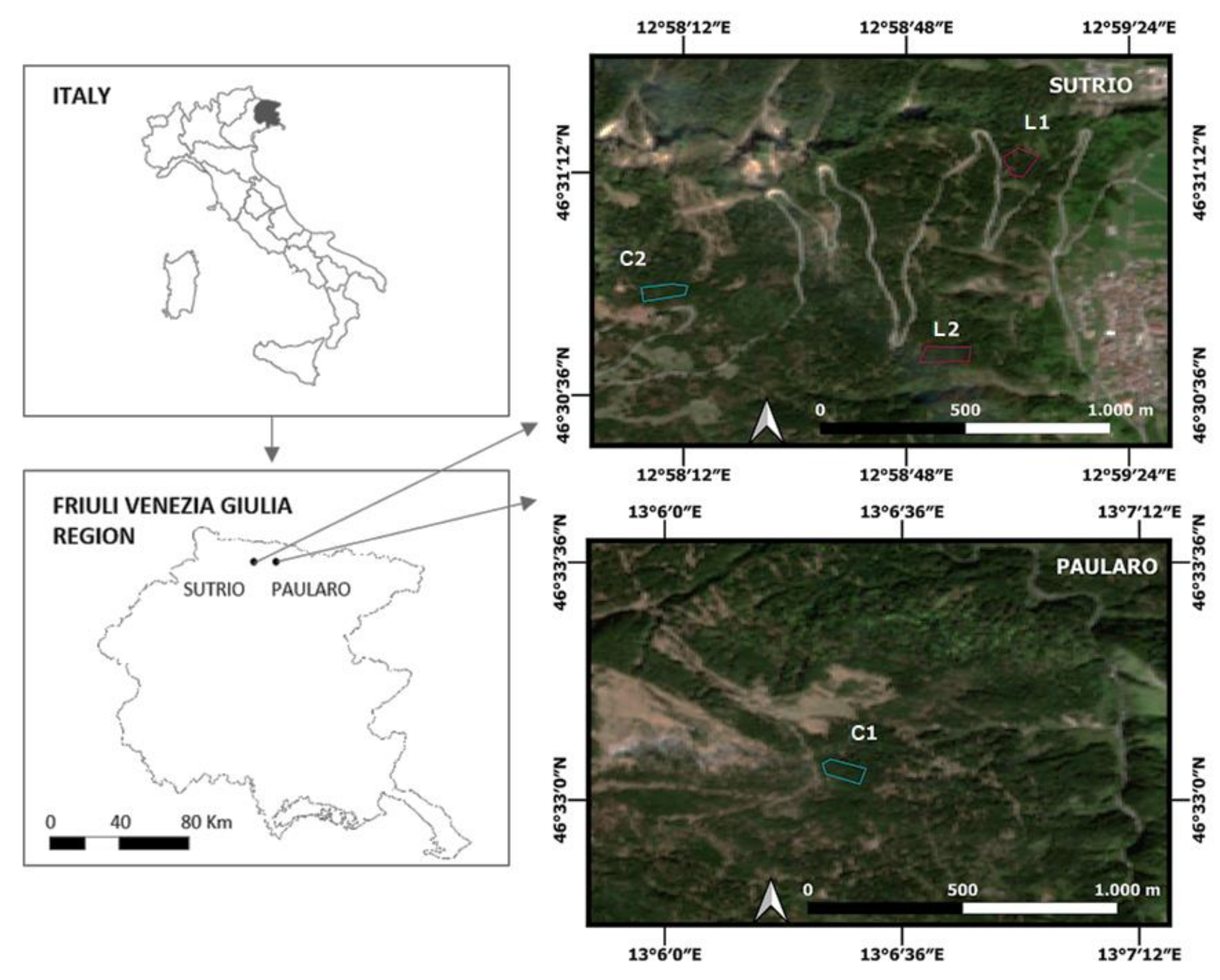

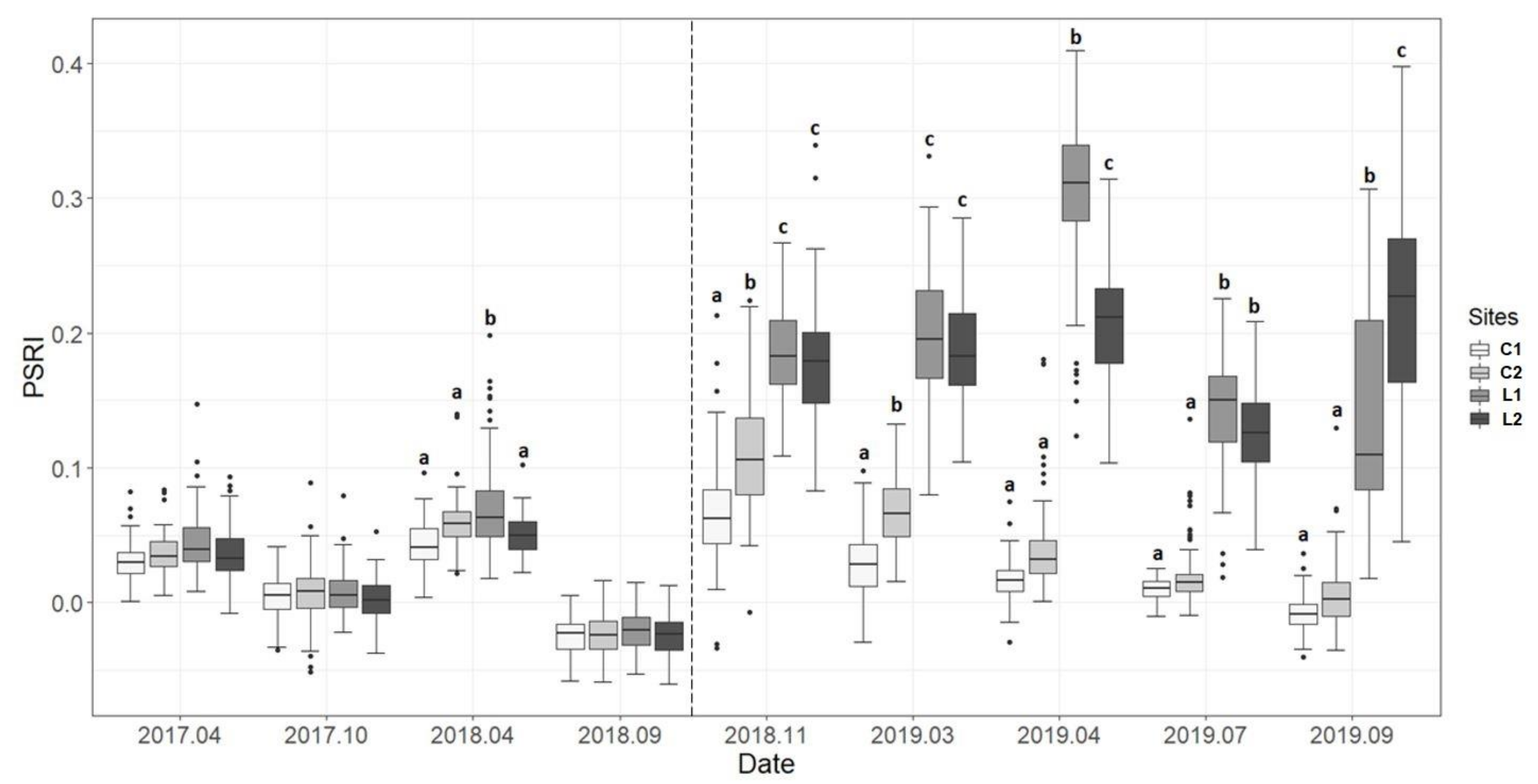

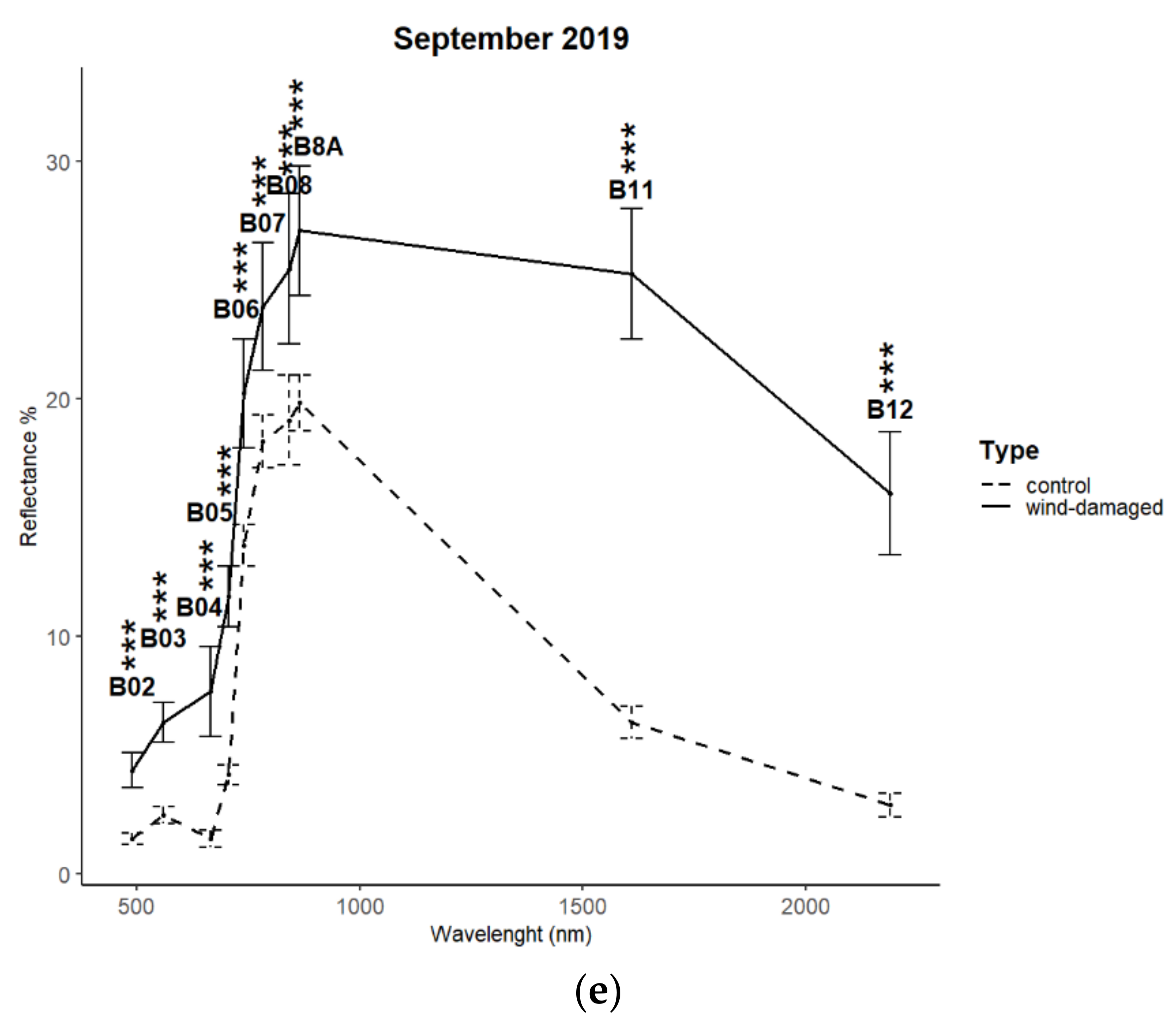
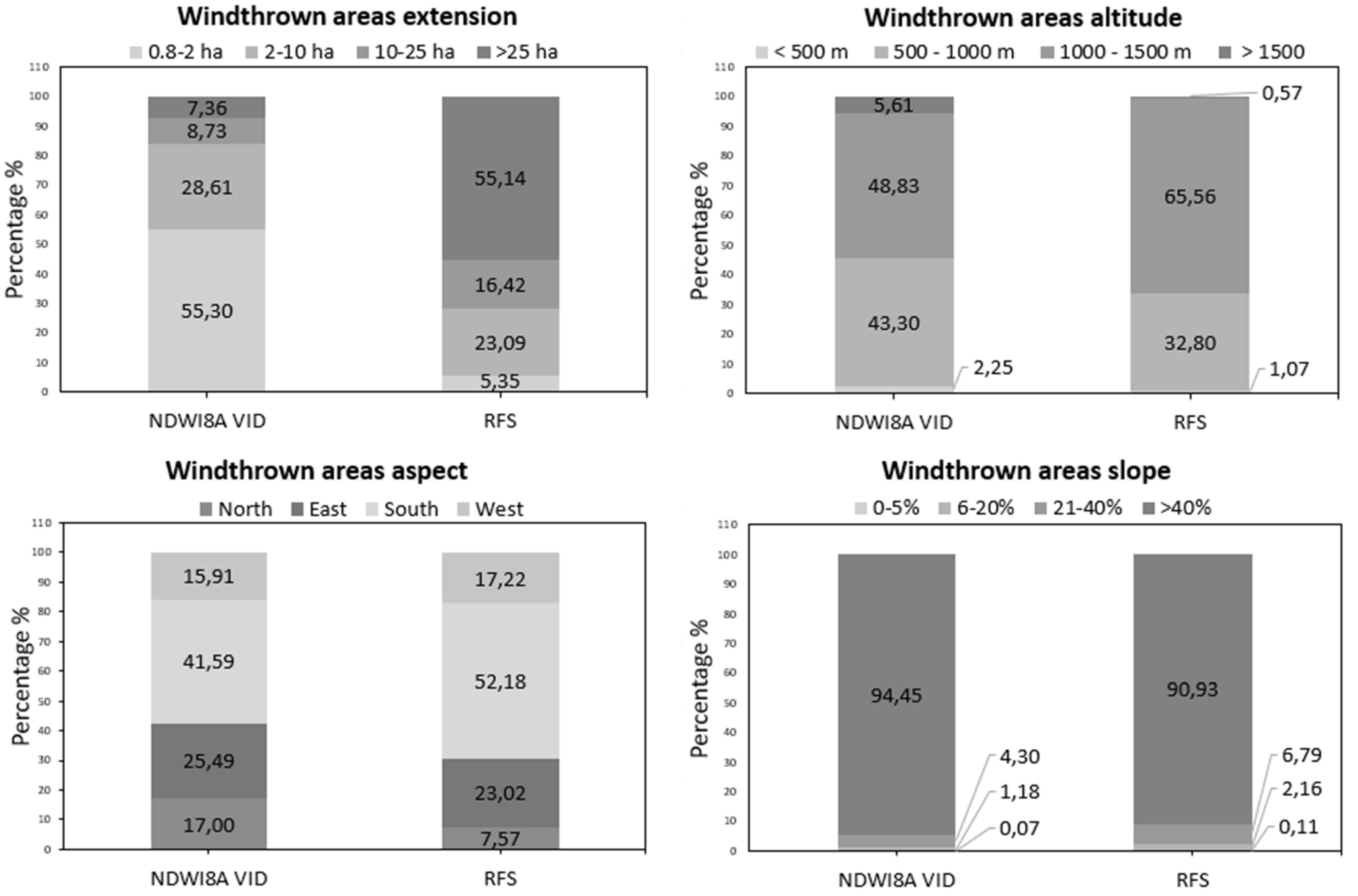
| Date | Product | Reference Period |
|---|---|---|
| 21 April 2017 | S2A_MSIL2A_20170421T100031_N0204_R122_T33TUM_20170421T100541.SAFE | 2017.04 |
| 08 October 2017 | S2A_MSIL2A_20171008T100031_N0205_R122_T33TUM_20171008T100322.SAFE | 2017.10 |
| 21 April 2018 | S2B_MSIL2A_20180421T100029_N0207_R122_T33TUM_20180421T120642.SAFE | 2018.04 |
| 26 September 2018 | S2A_MSIL2A_20180926T101021_N0208_R022_T33TUM_20180926T191545.SAFE | 2018.09 |
| 15 November 2018 | S2A_MSIL2A_20181115T101251_N0210_R022_T33TUM_20181115T114042.SAFE | 2018.11 |
| 05 March 2019 | S2A_MSIL2A_20190305T101021_N0211_R022_T33TUM_20190305T162851.SAFE | 2019.03 |
| 21 April 2019 | S2A_MSIL2A_20190421T100031_N0211_R122_T33TUM_20190421T131138.SAFE | 2019.04 |
| 23 July 2019 | S2A_MSIL2A_20190723T101031_N0213_R022_T33TUM_20190723T125722.SAFE | 2019.07 |
| 13 September 2019 | S2B_MSIL2A_20190913T100029_N0213_R122_T33TUM_20190913T142855.SAFE | 2019.09 |
| Index | Reference | Description |
|---|---|---|
| Green Normalized Difference Vegetation Index GNDVI = | [23] | GNDVI was suggested to avoid the NDVI saturation effect in dense canopy structures in order to correctly infer chlorophyll canopy content [24]. It uses the green band (B3, ~0.60 µm) as a replacement for the red one. The values range from −1 to 1, with growing values as green biomass increases. |
| Inverted Red-Edge Chlorophyll Index IRECI = | [25] | IRECI is one of the best indices for the estimation of leaf area index (LAI), namely the one-sided green leaf area per unit ground surface area. It has been also used to estimate canopy and leaves chlorophyll content. IRECI makes use of all Red-Edge (RE) Sentinel bands (B5, B6 and B7, respectively ~0.7 µm, 0.74 µm and 0.78 µm, the latter corresponding to maximum reflectance) and the red band (B4, ~0.65 µm, minimum reflectance) to characterize the RE slope. By the use of the B5/B6 ratio, IRECI does not put heavy emphasis on the red, which helps to avoid saturation at high chlorophyll concentrations, while utilizing the strong contrast of the B7 and B4 difference which is sensitive to LAI. |
| Normalized Difference Red-Edge Blue Index NDREDI = | [26] | NDREDI is a very recent index evolved in a study for windthrow detection in Germany from PSRI. Both NDREDI and PSRI, by applying the RE and blue spectral bands, proved to be suitable measures for the detection of windthrows. |
| Normalized Difference Vegetation Index NDVI = | [27] | In NDVI, the combination of the red band (B4, ~0.65 µm), sensible to chlorophyll content, and NIR band (B8, ~0.85 µm), sensible to leaf structure, permit the detection of vegetation. NDVI ranges between −1 and 1. Naked soils have values around 0, negative values are retrieved from water surfaces while positive values are found in vegetated areas, the higher values the greater is the biomass. It has been used for estimation of Leaf Area Index, biomass, chlorophyll concentration in leaves and plant productivity [28]. |
| Normalized Difference Water Index 11 NDWI = | [29] | NDWI combines NIR (~0.85 µm) and SWIR (~1.6 µm) bands for water stress monitoring in plants. SWIR reflectance reflects changes in both the vegetation water content and the spongy mesophyll structure in vegetation canopies. NIR reflectance is affected by leaf internal structure and leaf dry matter content but not by water content. The combination of NIR and SWIR removes variations induced by leaf internal structure and leaf dry matter content, improving the accuracy in retrieving the vegetation water content. Due to the high sensitivity of NDWI and NDWI8A to changes in water content of leaves, this index is efficient in detecting damage, monitoring drought periods and estimating yield depletion [30]. Index values vary from −1 to 1, they are negative when the vegetation is dry or on bare soils, while they are positive when the vegetation is green and rich in water [31,32]. |
| Normalized Difference Water Index 11 with 8A band NDWI8A = | ||
| Plant Senescence Reflectance Index PSRI = | [33] | PSRI was introduced to estimate the onset, the stage, relative rates and kinetics of the senescence process. An increase of reflectance between 0.55 and 0.74 µm (sensed by B4 and B6) accompanied senescence-induced degradation of chlorophyll, whereas in the range 0.4–0.5 µm (B2) it remains low due to retention of carotenoids. The index is sensitive to the carotenoids and chlorophyll ratio and it has been used as a quantitative measure of leaf senescence. |
| Specific Leaf Area Vegetation Index SLAVI = | [34] | SLAVI was developed to estimate the specific leaf area (SLA), namely the one side area of the leaf divided by its dry weight. It is based on red and near-infrared reflections, which have a high correlation with net photosynthesis, net primary production and leaf area index [35], and on SWIR reflection, which guarantees leaves water content estimation. SLAVI is negatively correlated with cellulose and lignin content. It is also sensitive to the volume and height of vegetation [36]. |
| Index | Coefficient | SE | p-Value | R2 | |
|---|---|---|---|---|---|
| NDWI8A | Intercept | 0.49 | 0.007 | *** | 0.80 |
| Treatment | −0.388 | 0.011 | *** | ||
| NDWI | Intercept | 0.473 | 0.021 | *** | 0.77 |
| Treatment | −0.4 | 0.006 | *** | ||
| NDVI | Intercept | 0.841 | 0.01 | *** | 0.76 |
| Treatment | −0.29 | 0.007 | *** | ||
| PSRI | Intercept | 0.025 | 0.003 | *** | 0.69 |
| Treatment | 0.163 | 0.005 | *** | ||
| SLAVI | Intercept | 4.122 | 0.062 | *** | 0.65 |
| Treatment | −2.813 | 0.106 | *** | ||
| GNDVI | Intercept | 0.774 | 0.003 | *** | 0.60 |
| Treatment | −0.145 | 0.005 | *** | ||
| IRECI | Intercept | −0.048 | 0.003 | *** | 0.32 |
| Treatment | −0.108 | 0.006 | *** | ||
| NDREDI | Intercept | 0.55 | 0.006 | *** | 0.03 |
| Treatment | −0.043 | 0.01 | *** | ||
Publisher’s Note: MDPI stays neutral with regard to jurisdictional claims in published maps and institutional affiliations. |
© 2021 by the authors. Licensee MDPI, Basel, Switzerland. This article is an open access article distributed under the terms and conditions of the Creative Commons Attribution (CC BY) license (https://creativecommons.org/licenses/by/4.0/).
Share and Cite
Olmo, V.; Tordoni, E.; Petruzzellis, F.; Bacaro, G.; Altobelli, A. Use of Sentinel-2 Satellite Data for Windthrows Monitoring and Delimiting: The Case of “Vaia” Storm in Friuli Venezia Giulia Region (North-Eastern Italy). Remote Sens. 2021, 13, 1530. https://doi.org/10.3390/rs13081530
Olmo V, Tordoni E, Petruzzellis F, Bacaro G, Altobelli A. Use of Sentinel-2 Satellite Data for Windthrows Monitoring and Delimiting: The Case of “Vaia” Storm in Friuli Venezia Giulia Region (North-Eastern Italy). Remote Sensing. 2021; 13(8):1530. https://doi.org/10.3390/rs13081530
Chicago/Turabian StyleOlmo, Valentina, Enrico Tordoni, Francesco Petruzzellis, Giovanni Bacaro, and Alfredo Altobelli. 2021. "Use of Sentinel-2 Satellite Data for Windthrows Monitoring and Delimiting: The Case of “Vaia” Storm in Friuli Venezia Giulia Region (North-Eastern Italy)" Remote Sensing 13, no. 8: 1530. https://doi.org/10.3390/rs13081530
APA StyleOlmo, V., Tordoni, E., Petruzzellis, F., Bacaro, G., & Altobelli, A. (2021). Use of Sentinel-2 Satellite Data for Windthrows Monitoring and Delimiting: The Case of “Vaia” Storm in Friuli Venezia Giulia Region (North-Eastern Italy). Remote Sensing, 13(8), 1530. https://doi.org/10.3390/rs13081530






